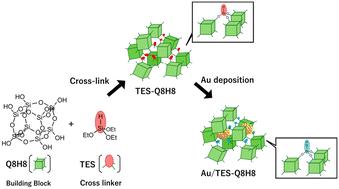由笼型硅氧烷衍生的多孔二氧化硅材料:分散金(0)纳米颗粒的结构约束和稳定性
IF 3.3
3区 化学
Q2 CHEMISTRY, INORGANIC & NUCLEAR
引用次数: 0
摘要
高度分散的金(Au)表现出独特的催化性能,与大块的金或更大的颗粒有很大的不同。然而,在保持其固有特性的同时实现这种分散仍然是一项挑战。这种困难经常出现,因为传统方法可以改变金本身的特性。本研究使用二氧化硅解决了这个问题,二氧化硅是一种以其与活性金属物种弱相互作用而闻名的支撑材料。具体来说,我们开发了一种新型的纳米多孔二氧化硅载体,使用笼型硅氧烷作为构建块,与硅氢基功能化。这些基团使现场还原Au3+离子,允许高度分散的Au负载,而不引入强相互作用的配体。重要的是,即使在煅烧之后,分散也被保留,这表明在多孔结构中存在约束效应。这种方法为在惰性载体上稳定Au提供了一种很有前途的策略,有可能推进用于多相催化的稳健高效的Au-silica催化剂的设计。本文章由计算机程序翻译,如有差异,请以英文原文为准。

Porous silica materials derived from cage-siloxane: structural confinement and stabilisation of dispersed Au(0) nanoparticles
Highly dispersed gold(Au) species exhibit unique catalytic properties that differ considerably from those of bulk Au or larger particles. However, achieving such dispersion while preserving their intrinsic characteristics remains a challenge. This difficulty often arises because conventional methods can alter the characteristics of the Au itself. This study addresses this issue using silica, a support material known for its weak interaction with active metal species. Specifically, we developed a novel nanoporous silica support functionalised with hydrosilyl groups using a cage-siloxane as a building block. These groups enable on-site reduction of Au3+ ions, allowing highly dispersed Au loading without introducing strongly interacting ligands. Importantly, the dispersion was retained even after calcination, indicating a confinement effect within the porous structure. This approach offers a promising strategy for stabilising Au species on inert supports, potentially advancing the design of robust and efficient Au-silica catalysts for heterogeneous catalysis.
求助全文
通过发布文献求助,成功后即可免费获取论文全文。
去求助
来源期刊

Dalton Transactions
化学-无机化学与核化学
CiteScore
6.60
自引率
7.50%
发文量
1832
审稿时长
1.5 months
期刊介绍:
Dalton Transactions is a journal for all areas of inorganic chemistry, which encompasses the organometallic, bioinorganic and materials chemistry of the elements, with applications including synthesis, catalysis, energy conversion/storage, electrical devices and medicine. Dalton Transactions welcomes high-quality, original submissions in all of these areas and more, where the advancement of knowledge in inorganic chemistry is significant.
 求助内容:
求助内容: 应助结果提醒方式:
应助结果提醒方式:


